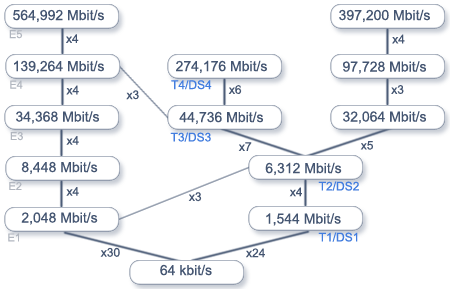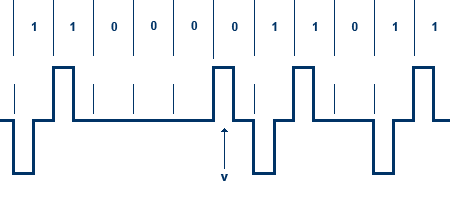|
G.703 interface Interface hierarchy described in the G.703 standard allows transmission of a number of 64 kbps channels. Base 64 kbps channel may be used to transmit one uncompressed phone call and may be also used to transfer other digital information.
The sum of component subchannels is smaller than the whole channel (e.g. 4 * 2048 kbps = 8192 kbps, not 8448 kbps) - the remaining part of the stream is used for synchronization or transmitting alarms and checksums.
Fig. 1 PDH hierarchy On the picture above you can see dependencies between various streams. Higher throughputs described in other standards were also included.
The HDB3 coding is used at 2048 kbps, 8448 kbps and 34 368 kbps.
Fig. 2 HDB coding Framing The framing method is different for each throughput, so we will focus on 2048 kbps framing - like one used in Tahoe devices. One frame consists of 256 bits numbered from 1 to 256. Frames are sent with frequency of 8000 Hz, which gives a total throughput of 2048000 bits per second. Each 8 subsequent bits of a frame form so-called timeslot. If each timeslot occupies 8 bits of each frame and frames are sent 8000 times per second, then one timeslot has throughput of 64 kbps. First 8 bits (timeslot 0) is used for synchronization. These bits take alternating functions in subsequent frames:
Si - bit for international use (e.g. CRC4 checksum) Apart from timeslot 0 used for synchronization, timeslot 16 is used for signaling - e.g. transmitting an information about incoming phone call in one of the channels. The signaling is sent in 16 subsequent frames. In the first one, in the 16th timeslot there are only spare bits. In each of the following frames there are 4 bits for two channels (8 bits in all - a whole timeslot). So 15 frames contain signaling for all the 30 free timeslots (from 1 to 15 and from 17 to 31).
CRC4 The Si bit may be used to transfer the CRC4 checksum. The four-bit checksum is transmitted in Si bits of eight subsequent frames. It is computed from 2048 bits of data sent in 8 previous frames. Such eight frame sequence is called a sub-multiframe (SMF). Every second SMF contains additional bits used to signal errors detected during the transmission. A sequence of two SMFs makes a full multiframe.
C1-C4 - CRC4 checksum bits |
|||||||||||||||||||||||||||||||||||||||||||||||||||||||||||||||||||||||||||||||||||||||||||||||||||||||||||||||||||||||||||||||||||||||||||||||||||||||||||||||||||||||||||||||||||||||||||||||||||||||||||||||||||||||||||||||||








